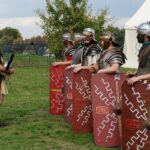The term “living history” describes the process of bringing history to life for the general public in a way that in most cases does not follow a planned script. Historical performance encompasses a continuum from well-researched attempts to recreate a well-known historical event for educational purposes, through performances with theatrical elements to competitive events for entertainment purposes. The line between amateur and professional presentations in living history museums can be blurred. While the latter usually use museum professionals and trained interpreters to help bring history to the public, some museums and historic sites use living history groups with high standards of authenticity for the same role at special events.
Living histories are usually designed to educate the public. These events are not necessarily mock battles, but instead aim to portray the lives and, more importantly, the lifestyles of the people of the time. This often includes both military and civilian experiences. Sometimes stories or acting sketches are used to draw viewers’ attention to or explain everyday life or military activities. Craft and cooking demonstrations, song and entertainment, and lectures are more common. Combat training or duels may also occur, even when there are no larger combat demonstrations.
Combat Demonstration
Combat demonstrations are mock battles put on by reconstructed organizations and/or individuals, primarily to show the public what battles might have been like in that period. Combat demonstrations are only partially based on actual battles, if at all, and may simply consist of demonstrations of basic tactics and maneuvering techniques.
Battle Reconstruction
Battle scenarios are reconstructions in the strictest sense of the word; battles are planned in advance so that companies and regiments perform the same actions as they did in the original battles. The simulated battles often “take place” on or near the original battlefield or in a location very similar to the original battlefield. These demonstrations vary greatly in size from a few hundred fighters to several thousand, as do the arenas used (proper balance can often make or break the spectacle for the audience).
Tactical Combat
Unlike battle reenactments, tactical battle events are usually closed to the public. Tactical battle scenarios are games in which both sides devise strategies and maneuver to defeat their opponents. Without a scenario, a basic set of agreed upon rules (physical boundaries, timelines, victory conditions, etc.) And judges on the ground, tactical battles can be seen as a form of real-time role play. If firearms are used, any real weapon fires blank cartridges (depending on gun control ordinances).
Tactical reconstruction is one of the activities of the Society for Creative Anachronism, which holds tournaments using worked (non-damaging) versions of medieval and renaissance weapons.
Commercial Reconstruction
Many castles that offer tours, museums and other historic tourist attractions hire actors or professional reenactors to add authenticity and experience. These reenactors usually recreate part of a particular town, village or event over a period of time. Commercial reenactment shows are usually staged according to a script. In some places, permanent authentic displays are set up. By their nature, they are usually living history presentations rather than tactical or battle reenactments, although some have larger temporary events.
In 2008, the Jean Lafitte National Historical Park and Preserve and the staff and buildings of Tryon Palace in North Carolina were the historical backdrop for life in the early 1800s depicted in the documentary film “The Mystery of the Mardi Gras Shipwreck.”

